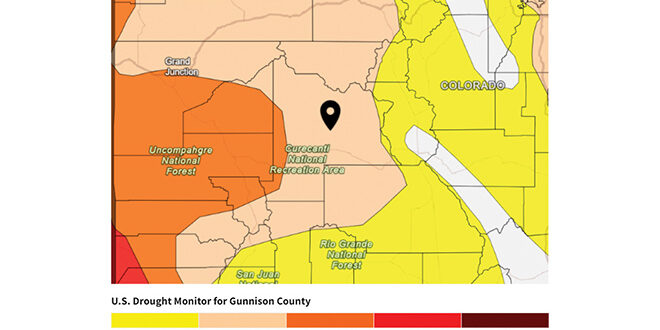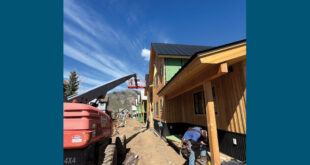Autumn weather will determine final conditions prior to winter
[ By Katherine Nettles ]
It might seem hard to believe with the consistent rain showers occurring over the past couple months, but Colorado’s persistent drought conditions cannot be cured with one robust monsoon season. The good news is that this particular monsoon season has improved conditions significantly across the state and Gunnison County, and the 30-day forecast appears positive for continuing that trend and potentially removing drought classifications in a small portion of the Gunnison Valley. It has also been good for trail maintenance in the valley.
“Yes, the rain has improved conditions in the Upper Gunnison Basin, but we are still classified as being in drought,” said Beverly Richards, water resource specialist with the Upper Gunnison River Water Conservancy District (UGRWCD).
The Upper Gunnison Basin has been in drought since September 17, 2019. According to the National Oceanic and Atmospheric Administration (NOAA) and National Integrated Drought Information System (NIDIS), 100% of Gunnison County is still classified as abnormally dry (D0) and 96.49% is classified as in moderate drought (D1); however, 8.94% is classified as in severe drought (D2) and no part is classified as being in extreme drought (D3).
Those conditions, last updated on August 23, are an improvement from the previous percentages reported on July 5, when 60% of Gunnison County was classified as in severe drought (D2). Most of that D2 area was downgraded to moderate drought over the past 30 days.
Shea Early, Crested Butte Public Works director, reports that 6.58 inches of rain fell in CB this summer, with 1.77 inches in June, 2.43 inches in July and 2.38 inches in August. billy barr, who tracks precipitation in Gothic year-round, reports that Gothic has received 6.22 inches of rain this summer compared with a 22-year average of 6.12 inches. “So basically in Gothic it was an average rain summer,” he summarized.
Richards received word from the National Weather Service as of August 24 that the Upper Gunnison Basin is now at 100% of average precipitation for the year to date, which is up from slightly below normal at the previous update earlier in August.
NOAA/NIDIS classified July in Gunnison County as the 41st wettest July on record over the past 128 years, with .35 inches more than what is considered normal.
Tacky trails
Recreationally, Crested Butte Mountain Bike Association (CBMBA) director Dave Ochs says the local trails are in good shape and soaking up the rainfall well,” he said, describing conditions as “super tacky – really fun riding!”
Ochs explained some added benefits to the heavy daytime rains that have made an appearance. “It’s been good to see some of the downpours during the day. Trail crews get to see how water moves after each of those bigger/heavier downpours, and we can maintain accordingly. CBCC crews have been making ‘drains’ a priority this year, and you can see it with minimal puddling and dry trails.
“Of course, can’t get to ‘em all and there’s some mud and puddling out there. Overall, it’s been great for the conditions all around, awesome that we’re not breathing smoke this summer, and hopefully adding some groundwater to the local supplies,” concluded Ochs.
Long-range outlook
Richards said forecasters are not yet providing a percentage of the county where the drought designation removal is likely to happen, but confirmed, “All but approximately 9% of the county moved from severe to moderate. The area that is in abnormally dry conditions is located in the eastern edge of the county and the severe area is located on the western side.”
NOAA is predicting a 68% chance that the area might move from La Nina to Neutral next Spring, reported Richards. “This is good for us as La Nina historically means warmer temperatures and below normal precipitation in southern areas of the state. The Colorado River Basin Forecast center said the precipitation that we did receive improved base flows and soil moisture conditions, but August-October weather will determine final conditions prior to winter,” she said, based on information provided at the Aspinall Operation meeting held on August 24.
The long-range forecast, which combines several drought monitoring “products” and indices and six-month, one-year, two-year and five-year predictions, indicates that Gunnison County will range mostly in the D0 to D1 categories in the longer term with geographical variations ranging from wet conditions in the 70 to 80 percentiles (W) to severe and exceptional drought of D3 and D4.
The NOAA/NIDIS drought monitor website describes DO conditions as: “Hay production decreases; rangeland is dry. Irrigation begins sooner;” D1 conditions are described as: “Rangeland growth is stunted; very little hay is available. Dryland crops suffer. Wildfires increase;” D2 conditions are described as: “Farmers reduce planting; producers sell cattle. Fire season is extended. Snowpack is low; surface water levels are low; river flow is reduced; D3 is described as: “Pasture conditions worsen. Large fires develop. Reservoirs are extremely low; mandatory water restrictions are implemented; water temperature increases;” and D4, exceptional drought, is described as “Dust storms and topsoil removal are widespread; Agricultural and recreational economic losses are large.”
More information can be found at drought.gov.
 The Crested Butte News Serving the Gunnison Valley since 1999
The Crested Butte News Serving the Gunnison Valley since 1999


